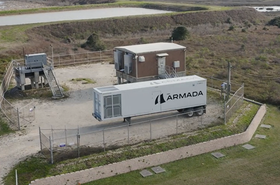The private network space received a jolt this week with Amazon Web Services (AWS) ditching its Private 5G platform, a move that highlights the increasingly complex nature of cracking the private network space. However, telecom operators remain very much on the case, with some even noting there remains a place for hyperscalers in helping operators drive enterprise adoption of private network services.
AWS initially unveiled its ambitious Private 5G plans in late 2021, followed by a commercial platform launched the following year. The big-picture plan was to use AWS’ deep well of data center-focused cloud infrastructure that it has found some success with in powering commercial 5G networks on a smaller scale for enterprise locations.
However, unlike its commercial 5G network partnerships, the Private 5G platform required AWS to deal with the network complexity, which was ultimately its undoing.
Despite that blip, operators remain vigilant.
David Joosten, business director for Vodafone’s Americas and Partner Markets, acknowledged what many have claimed in that the private network space has so far failed to reach its lofty expectations. Despite some highly publicized early trials and proof-of-concepts (PoCs) using mobile private networks (MPNs), the market has been stymied by the inability to link early efforts into commercial realities.
“Up until a year ago, the reputation that MPNs had, or the struggle that a lot of people had with MPNs, is that they we did a lot of PoCs, there was a lot of tries on use cases – some of them were successful, others were not – but in a lot of cases, they didn't go into production, or didn't really get industrialized by large enterprises,” Joosten said.
In absorbing those early struggles, Joosten said he is starting to see rapid maturity in the market.
“I think looking into in the last couple of months and probably year, there is definitely, I think, more uptake on the technology,” Joosten said.
This notion was backed by Ericsson CFO Lars Sandstrom, who during that vendor’s latest earnings call noted that its enterprise wireless solution sales increased 19 percent, “with strong growth in private 5G and neutral host solutions.”
This uptake has been bolstered by enterprises having a better understanding of how 5G technology can support more advanced applications compared to Wi-Fi technology and the growing globalization of use cases that is driving scale.
“We are seeing a lot of multi-country types of deployments that gives it the scale of being able to invest in it,” Joosten said of private networks. “There are still companies that are struggling to find more use cases for it, because if you implement it you need a lot of use cases in the factory or in your processes that allow you to really monetize it for the investment that it costs, so I think that will continue to be something that as we move along, will always be a requirement, that you need to keep finding good use cases for the technology.”
Who can drive private network adoption?
Not surprisingly, Joosten thinks telecom operators like Vodafone are in the best position to capitalize on this opportunity.
“I've always been a firm believer of the telco to take ownership of that, because managing networks for mobile networks is something that sits in the DNA of an operator, whether that's Vodafone or any other carrier. It is an inherent part of our DNA,” Joosten said, adding that this includes the complicated task of managing spectrum to power private networks.
As AWS noted, spectrum remains one of the more challenging aspects of private network deployments. Some governments have set aside quasi-licensed spectrum bands that are managed by a central party and in which enterprises can lease to power private network deployments, but the validity of those models have been called into question.
Operators, on the other hand, are throwing their licensed spectrum assets at this challenge, including their voluminous holdings in the millimeter-wave (mmWave) spectrum bands.
Joosten’s operator-centric view is not to say that there isn’t a place for others, noting that Vodafone, at least, stays away from the application layer.
“We don't do application integration or anything like that,” Joosten said. “We do build the foundation, and we do give everything that goes from the network to the managed service of the network, but then individual components … for example, software development, or really specific type of hardware, that's something the customer is going to have to acquire themselves.”
There are operator-backed efforts in place to help bridge this network-to-application gap. The most ambitious appears to be an API-focused, for-profit venture launched late last year that involved a dozen of the world’s largest telecom operators – including Vodafone – partnering with Ericsson and Google Cloud.
Joosten also noted that he sees a place for hyperscalers in the stack, or at least at the edge of the stack.
“We did something with AWS with Edge, or 5G on the Edge, and then having applications that sit in a hyperscaler’s footprint that then use an MPN,” Joosten said, pointing to end-user services like streaming video or in support of sporting events. “That’s where an MPN, or at least a 5G deployment, in combination with some kind of hyperscaler solution absolutely makes sense.”
Other operators have also expressed interest in this private network-based edge opportunity.
Verizon CEO Hans Vestberg recently told an audience at an investor conference that there is a growing link in using private networks to boost edge network use.
“I think that many, together with me, believes that a lot of the genAI applications that's going to be enterprise driven, they're going to sit at the edge of the network because of transport costs, security, and privacy, many companies, like Verizon, you want to have it [on-premises], whatever you have, you want it [on-premises]. That could be a third party, but still it's going to be our data centers,” Vestberg said of this link and opportunity. “I think this hangs together all the way from private 5G network and edge computing.”
Vestberg has admittedly been willing this opportunity along for some time, noting, “we were very early on mobile edge compute, maybe too early, and I take that responsibility. But I'd rather be too early on something than being too late. Now we're sitting in a really good position on monetizing that investment and our assets we have there.”
Joosten added that this winnowing of focus on the market could further accelerate adoption.
“Like I said, the early days where you need to figure it out and there's 100 people sending you messages on LinkedIn saying they have the best MPN solution, it has matured to an extent, and that is definitely going to help drive adoption,” Joosten said.




